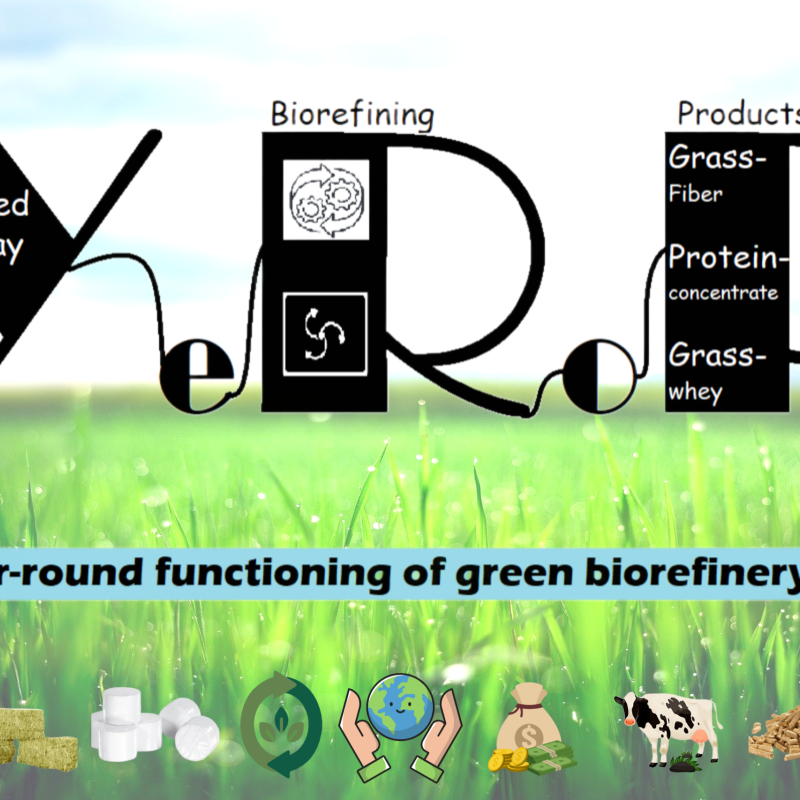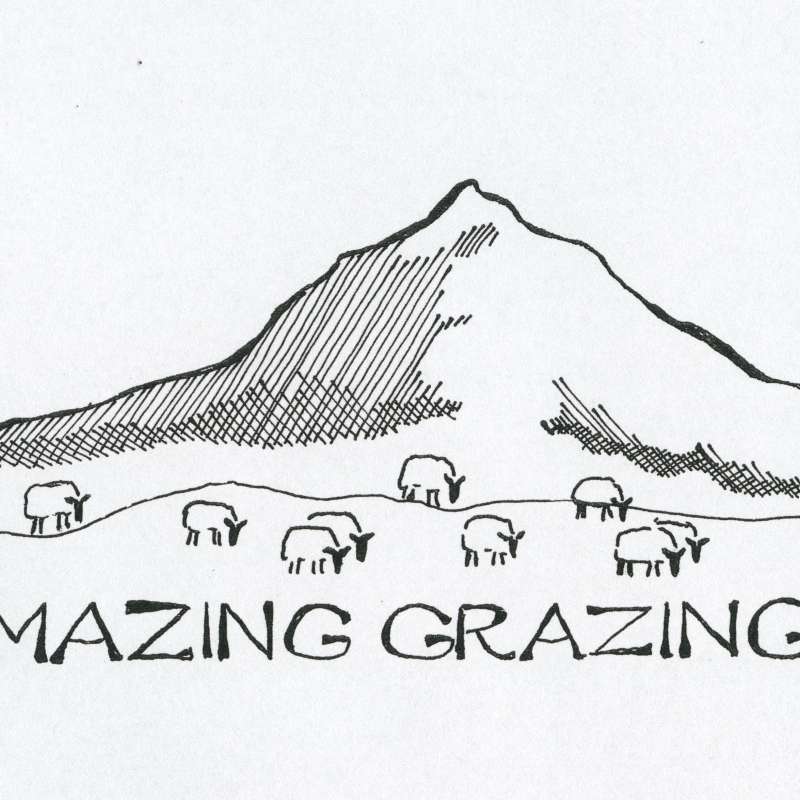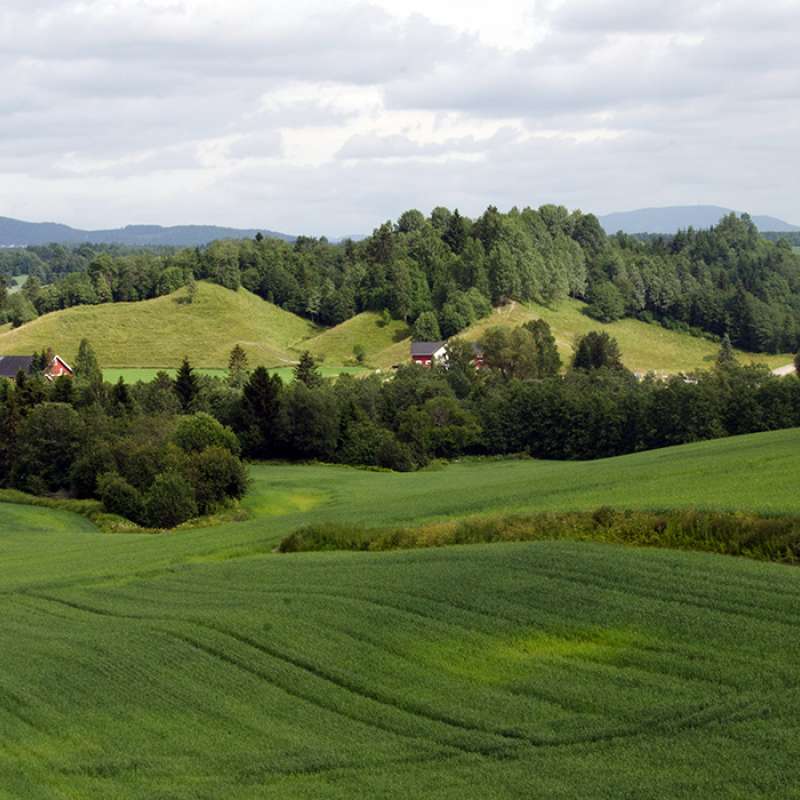Håvard Steinshamn
Research Professor
(+47) 906 82 643
havard.steinshamn@nibio.no
Place
Tingvoll
Visiting address
Gunnars veg 6, 6630 Tingvoll
Biography
Abstract
European livestock sectors rely heavily on imported protein feeds, presenting challenges regarding sustainability and supply security. Green biorefineries (GBR) represent a local alternative where protein concentrates are extracted from grassland crops, but the environmental performance of these systems depends on feedstock cultivation practices. This study combined field trials and life cycle assessment (LCA) to quantify how nitrogen (N) fertilization rates, clover inclusion rates, and feedstock management (fresh vs. ensiled) affect dry matter (DM) and crude protein (CP) biomass yields, as well as subsequent climate impact, and agricultural land use of GBR products. The results reveal that N fertilization during cultivation of feedstock biomass plays a critical role in the climate impact of green biorefining, and that including legumes enhances GBR sustainability. Increasing N fertilization from 0 to 240 kg N ha−1 in red clover–grass swards increased DM and CP biomass yields but also increased soil N₂O emissions and upstream fertilizer burdens. Under no N fertilizer treatment, biological N fixation supported high yields, resulting in the lowest net climate footprint in the ensuing LCA of the GBR process. However, this treatment also required around 60 % more land than the high N treatment. Processing ensiled feedstock further reduced the climate impact compared to fresh biomass by retaining more CP in the liquid fraction and eliminating several biorefinery steps. However, this benefit in this case was linked to the use of the liquid phase rather than ensiling itself, and similar outcomes could be achieved with fresh biomass if processed accordingly and used immediately after production. Future work must expand system boundaries to include transport, storage, and animal-feeding stages, and develop farm-level strategies that align GBR practices with regional conditions.
Authors
Kristian Hansen Håvard Steinshamn Sissel Hansen Matthias Koesling Tommy Dalgaard Bjørn Gunnar HansenAbstract
To evaluate the environmental impact across multiple dairy farms cost-effectively, the methodological frame- work for environmental assessments may be redefined. This article aims to assess the ability of various statistical tools to predict impact assessment made from a Life Cyle Assessment (LCA). The different models predicted estimates of Greenhouse Gas (GHG) emissions, Energy (E) and Nitrogen (N) intensity. The functional unit in the study was defined as 2.78 MJMM human-edible energy from milk and meat. This amount is equivalent to the edible energy in one kg of energy-corrected milk but includes energy from milk and meat. The GHG emissions (GWP100) were calculated as kg CO2-eq per number of FU delivered, E intensity as fossil and renewable energy used divided by number of FU delivered, and N intensity as kg N imported and produced divided by kg N delivered in milk or meat (kg N/kg N). These predictions were based on 24 independent variables describing farm characteristics, management, use of external inputs, and dairy herd characteristics. All models were able to moderately estimate the results from the LCA calculations. However, their precision was low. Artificial Neural Network (ANN) was best for predicting GHG emissions on the test dataset, (RMSE = 0.50, R2 = 0.86), followed by Multiple Linear Regression (MLR) (RMSE = 0.68, R2 = 0.74). For E intensity, the Supported Vector Machine (SVM) model was performing best, (RMSE = 0.68, R2 = 0.73), followed by ANN (RMSE = 0.55, R2 = 0.71,) and Gradient Boosting Machine (GBM) (RMSE = 0.55, R2 = 0.71). For N intensity predictions the Multiple Linear Regression (MLR) (RMSE = 0.36, R2 = 0.89) and Lasso regression (RMSE = 0.36, R2 = 0.88), followed by the ANN (RMSE = 0.41, R2 = 0.86,). In this study, machine learning provided some benefits in prediction of GHG emission, over simpler models like Multiple Linear Regressions with backward selection. This benefit was limited for N and E intensity. The precision of predictions improved most when including the variables “fertiliser import nitrogen” (kg N/ha) and “proportion of milking cows” (number of dairy cows/number of all cattle) for predicting GHG emission across the different models. The inclusion of “fertiliser import nitrogen” was also important across the different models and prediction of E and N intensity.
Abstract
No abstract has been registered

Division of Food Production and Society
Potential of biorefining fresh and preserved forages for year-round green protein supply in Norway
This YeRoP-project (Potential of biorefining fresh and preserved forages for

Division of Forest and Forest Resources
#Amazing grazing - bærekraftig kjøtt og ull fra sau som beiter i norsk utmark
Kjøtt og ull fra norske sauer kommer fra gårder med ulikt ressursgrunnlag, ulike driftsopplegg og ulik ressursbruk. I dette prosjektet skal vi undersøke sauebonden sitt driftsopplegg, forbrukeren sin innsikt, og rammevilkårene som både bonden og forbrukeren må forholde seg til. Hvordan kan produksjonen forbedres, og hvordan kan forbrukeren få mer kunnskap og nærhet til hva beitebruk bidrar med gjennom produktene?

Division of Food Production and Society
Visions and the consequences - analysing visions for Norwegian agriculture and its consequences for food security
Norsk matsikkerheit kan bli - og er alt til ein viss grad - truga av internasjonale konfliktar, handelssanksjonar, samanbrot av internasjonal distribusjonssystem, klimaendringar, utbrot av plante- og dyresjukdommar og store endringar i etterspurnad og tilgang på mat globalt som hindrar tilstrekkeleg fôr- og matimport. Matsikkerheit er i Noreg ofte assosiert med sjølvforsyningsgraden av matvarer. I prosjektet vil vi vurdere og evaluere grunnlaget, oppslutnad, moglegheiter og avgrensingar for målet om auka sjølvforsyning av mat frå norsk jordbruk og vurdere kor langt ein auke i sjøforsyningsgraden vil auke nasjonal matsikkerheit. Først vil vi køyre ein prosess med aktørar innan matproduksjonen, frå produksjon til omsetnad av mat, og andre interessentar for å identifisere eksisterande narrativ om norsk matproduksjon og dei ideologiske og moralske forskjellane mellom narrativ. Vidare vil vi rekruttere medlemmar til grupper som representerer eksisterande narrativ for å definere det vi kallar "idealtypane" av framtidas matsystem. Dette vil skje gjennom ei rekkje tverrfaglege seminar med medlemmane av gruppene og dei involverte forskarane. Dei definerte "idealtypane" for matsystem vil deretter bli omsett til kvantitative inndata til modellar og analysert. Resultat frå modellkøyringane er produksjonsmengd av ulike jordbruksvarer, miljømessige og økonomiske konsekvensar, kosthaldspåverknad og sjølvforsyningsgrad av jordbruksprodukt. Modellresultata vil bli evaluerte med involvering av interessentar og om naudsynt køyrd om att. Dei endelege modellresultata vil deretter bli brukte til å vurdere effektane av dei ulike "idealtypane" på fleire indikatorar for norsk matsikkerheit. Resultata av vurderinga av sjølvforsyningsgrad og matsikkerheit vil bli kommunisert og diskutert med avgjerdstakarar og aktørar med interesse i og for jordbruk og matproduksjon. Vår ambisjon er brei formidling og debatt om resultata, og vi vil såleis bruke ulike kommunikasjonskanalar
.jpg?quality=60)
Division of Food Production and Society
Cultivating sustainable changes in livestock feed production and feeding practices (Feed&Feeding)
The project will evaluate various strategies for feed production and feeding practices to enhance the sustainability of Norway's food system and support national agricultural policy goals. These strategies include adjusting livestock diets, improving breeding and animal health, and introducing new protein sources for feed. The project will assess environmental impacts, such as land use changes, greenhouse gas emissions, soil carbon levels, nutrient balances, and biodiversity, as well as socioeconomic impacts, including food security, economic and social sustainability, and the viability of rural communities.
